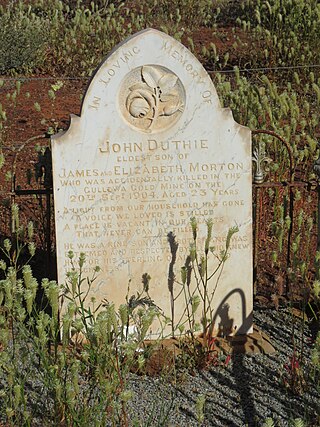
Mining in Western Australia, together with the petroleum industry in the state, accounted for 94% of the State's and 46% of Australia's income from total merchandise exports in 2019–20. The state of Western Australia hosted 123 predominantly higher value and export-oriented mining projects and hundreds of smaller quarries and mines. The principal projects produced more than 99 per cent of the industry's total sales value.

The Western Australian gas crisis was a major disruption to natural gas supply in Western Australia, caused by the rupture of a corroded pipeline and subsequent explosion at a processing plant on Varanus Island, off the state's north west coast on 3 June 2008. The plant, operated by Apache Energy, which normally supplied a third of the state's gas, was shut down for almost two months while a detailed engineering investigation and major repairs were carried out. Gas supply from the plant partially resumed in late August. By mid-October, gas production was running at two-thirds of normal capacity, with 85% of full output restored by December 2008.

The petroleum industry in Western Australia is the largest contributor to the country's petroleum exports. Western Australia's North West Shelf (NWS) is the primary location from which production originates. Oil exports are shipped from Port Hedland.

The Gold Stealing Detection Unit (GSDU), or Gold Stealing Detective Squad (GSDS), is a special unit of the Western Australian Police, based in Kalgoorlie, Western Australia. It investigates criminal activity and allegations at all stages of the gold production process in the state.
The Central Norseman gold mine is located at Norseman, Western Australia. Norseman lies at the southern end of the Norseman-Wiluna Greenstone Belt, in the Eastern Goldfields Province of the Yilgarn Block, Western Australia.
The Mount Morgans Gold Mine is a gold mine located 37 km west-southwest of Laverton, Western Australia.
The South Kalgoorlie Gold Mine is a gold mine located south-west of Kalgoorlie, Western Australia. The mine is sometimes also referred to as "South Kal Mines - New Celebration", being a merger of the former New Celebration Gold Mine and the Jubilee Gold Mine, which were combined in 2002.

Gold mining in Western Australia is the third largest commodity sector in Western Australia (WA), behind iron ore and LNG, with a value of A$17 billion in 2021–22. The 6.9 million troy ounces sold during this time period was the highest amount in 20 years and accounted for almost 70 percent of all gold sold in Australia.
The Department of Mines and Petroleum was a department of the Government of Western Australia until it was superseded by the Department of Mines, Industry Regulation and Safety on 1 July 2017. The department was formed on 1 January 2009, out of the former Department of Industry and Resources and Department of Consumer and Employment Protection, which were split into three new departments, the Department of Mines and Petroleum, the Department of State Development and the Department of Commerce.
The Department of State Development was a department of the Government of Western Australia. The department was formed on 1 January 2009, out of the former Department of Industry and Resources and Department of Consumer and Employment Protection, which were split into three new departments, the Department of State Development, the Department of Mines and Petroleum and the Department of Commerce.

Iron ore mining in Western Australia, in the 2018–19 financial year, accounted for 54 percent of the total value of the state's resource production, with a value of A$78.2 billion. The overall value of the minerals and petroleum industry in Western Australia was A$145 billion in 2018–19, a 26 percent increase on the previous financial year.

Fatality statistics in the Western Australian mining industry captures the number of people killed in the industry in the Australian state of Western Australia. During the period 2000-2012 (inclusive), a total of 52 fatalities occurred. In 2006, the Chamber of Minerals and Energy of Western Australia commissioned a taxonomic study to analyse the 306 mining fatalities which occurred between 1970 and 2006. The Department of Mines and Petroleum, later renamed the Department of Mines, Industry Regulation and Safety, the governing authority for the industry in the state, has published statistics for fatalities in mining dating back to 1943 and intends to publish statistics dating back to 1886, though early records are not expected to be exhaustive.

Nickel mining in Western Australia has been an industry that has had many fluctuations of fortune in its history. Large fluctuations in the world nickel price have seen mines close and reopen on several occasions.
The Department of Mines, Industry Regulation and Safety is a department of the Government of Western Australia. The department was formed on 1 July 2017, out of the former Department of Mines and Petroleum and Department of Commerce.

Copper mining in Western Australia is relatively minor on a world scale, accounting for less than one percent of the world's production in 2021–22.
Bulong Nickel Mine was a surface nickel and cobalt mine near Bulong, Western Australia, 40 kilometres (25 mi) east of Kalgoorlie, adjacent to Lake Yindarlgooda.
Nova Mine or Nova Operation is an underground cobalt, copper and nickel mine at Fraser Range, 160 kilometres (99 mi) east-northeast of Norseman, in the Shire of Dundas, Western Australia.
Forrestania Operation is an underground nickel mine at Forrestania, 80 kilometres (50 mi) east-southeast of Hyden, in the Shire of Kondinin, Western Australia.
Savannah Mine or Savannah Nickel-Copper-Cobalt Mine is an open cut and underground nickel, copper and cobalt mine 104 km (65 mi) north-northeast of Halls Creek in the Kimberley region of Western Australia.

Black Swan Nickel Mine is an inactive surface and underground nickel mine near Kanowna, Western Australia.







